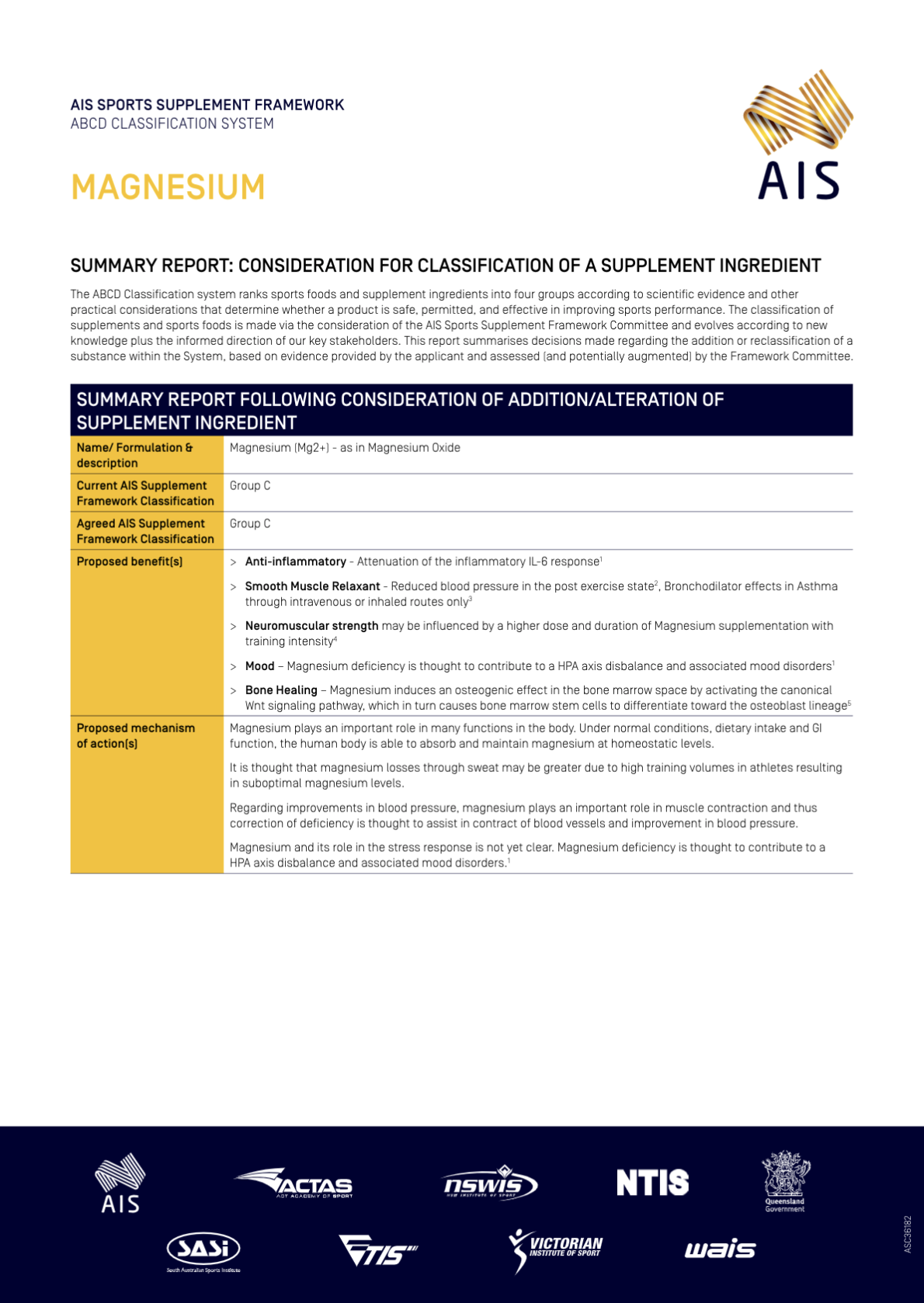Phosphate
Phosphate
(Phosphorus)
Name / Formulation and description: Phosphorus is a non-metallic essential nutrient, with about 11–14 g phosphorus per kg of fat-free mass (FFM) stored in the human body. Of which ~85% is located in the skeletal system. Comes in three forms, including sodium, calcium & potassium phosphate. However, most research is on sodium phosphate.
Current AIS Supplement Framework Classification: Group B (Other) Agreed AIS Supplement Framework Classification: Group C

36182_Supplements-fact-sheets_Phosphate.pdf
Current investigations of phosphate supplementation have focused on the physiological and performance-related outcomes of laboratory protocols including graded exercise tests to exhaustion, the 30-s Wingate test, 6 × 20 m (~3– 4 s) repeat sprint efforts, and TT situations ranging in duration from 3–60 min. Overall, there is equivocal evidence of performance enhancement from phosphate supplementation.1
Proposed benefits include:
- Increased aerobic capacity.
- Increased peak power output.
- Increased anaerobic threshold.
- Improved myocardial and cardiovascular responses to exercise.
The proposed mechanisms underpinning these benefits include an enhanced rate of ATP and PCr resynthesis; improved buffering capacity to support high rates of anaerobic glycolysis; improvement of myocardial contractility leading to increased cardiac efficiency; and an increased erythrocyte 2,3 diphosphoglycerate 2,3 DPG concentration, leading to a reduced affinity of oxygen with haemoglobin and a greater unloading of oxygen to the peripheral tissues.
In some instances, phosphate has been shown to enhance VO2max 2, 3, anaerobic threshold3, and cycling TT performance.4 However, in the case of repeated sprints, the magnitude of benefit has been shown to be varied and unclear.5 Finally, there is also a large amount of contrary evidence from the same physiological and performance measures that suggests phosphate supplementation (in isolation, or in combination with other buffer agents) has no impact on exercise capacity or performance outcomes.6, 7, 8, 9
Current evidence regarding the efficacy of phosphate supplementation remains unclear, since there exists no evidence to suggest an accumulation of this supplement in the muscle, where a number of the reported mechanism are suggested to take effect.
Typically, phosphate supplementation is achieved over a 3–6 day period, with a total daily dose of ~50 mg/kg of fat-free mass (~3–5 g/ day) consumed in single or split doses throughout the day. This is often associated with GI distress.2, 9 However, tolerance is improved by concurrent consumption with ~300 ml of a carbohydrate-rich fluid.10
The use of this supplement for enhanced athletic performance is likely questionable, with further research needed to fully explore its true effect.
- Peeling, Binnie, Goods, Sim & Burke. (2018). Evidence based supplements for the enhancement of athletic performance. Int J Sport Nutr Exerc Metab, 28, 178-87.
- Cade, Conte, Zauner, Mars, Peterson,, Lunne, & Packer. (1984). Effects of phosphate loading on 2, 3-diphosphoglycerate and maximal oxygen uptake. Med Sci Sports Exerc, 16, 263-268.
- Kreider, Miller, Williams, Somma, & Nasser. (1990). Effects of phosphate loading on oxygen uptake, ventilatory anaerobic threshold, and run performance. Medicine & Science in Sports & Exercise, 22(2), 250–256.
- Folland, Stern & Brickley. (2008). Sodium phosphate loading improves laboratory cycling time-trial performance in trained cyclists. J Sci Med Sport, 11, 464–468.
- Kopec, Dawson, Buck & Wallman. (2016). Effects of sodium phosphate and caffeine ingestion on repeated-sprint ability in male athletes. J Sci Med Sport, 19, 272-276.
- Brewer, Dawson, Wallman & Guelfi. (2014). Effect of sodium phosphate supplementation on cycling time trial performance and VO2 1 and 8 days post loading. J Sports Sci Med, 13, 529–534.
- Goss, Robertson, Riechman, Zoeller, Dabayebeh, Moyna & Metz. (2001). Effect of potassium phosphate supplementation on perceptual and physiological responses to maximal graded exercise. Int J Sport Nutr Exer Metab, 11, 53–62.
- Kraemer, Gordon, Lynch, Pop & Clark. (1995). Effects of multibuffer supplementation on acid-base balance and 2, 3-diphosphoglycerate following repetitive anaerobic exercise. Int J Sports Nutr, 5, 300–314.
- West, Ayton, Wallman & Guelfi. (2012). The effect of 6 days of sodium phosphate supplementation on appetite, energy intake, and aerobic capacity in trained men and women. Int J Sport Nutr Exerc Metab, 22, 422-429.
- Brewer, Dawson, Wallman & Guelfi. (2013). Effect of repeated sodium phosphate loading on cycling time-trial performance and VO2peak. Int J Sport Nutr Exerc Metab, 23, 187-194.